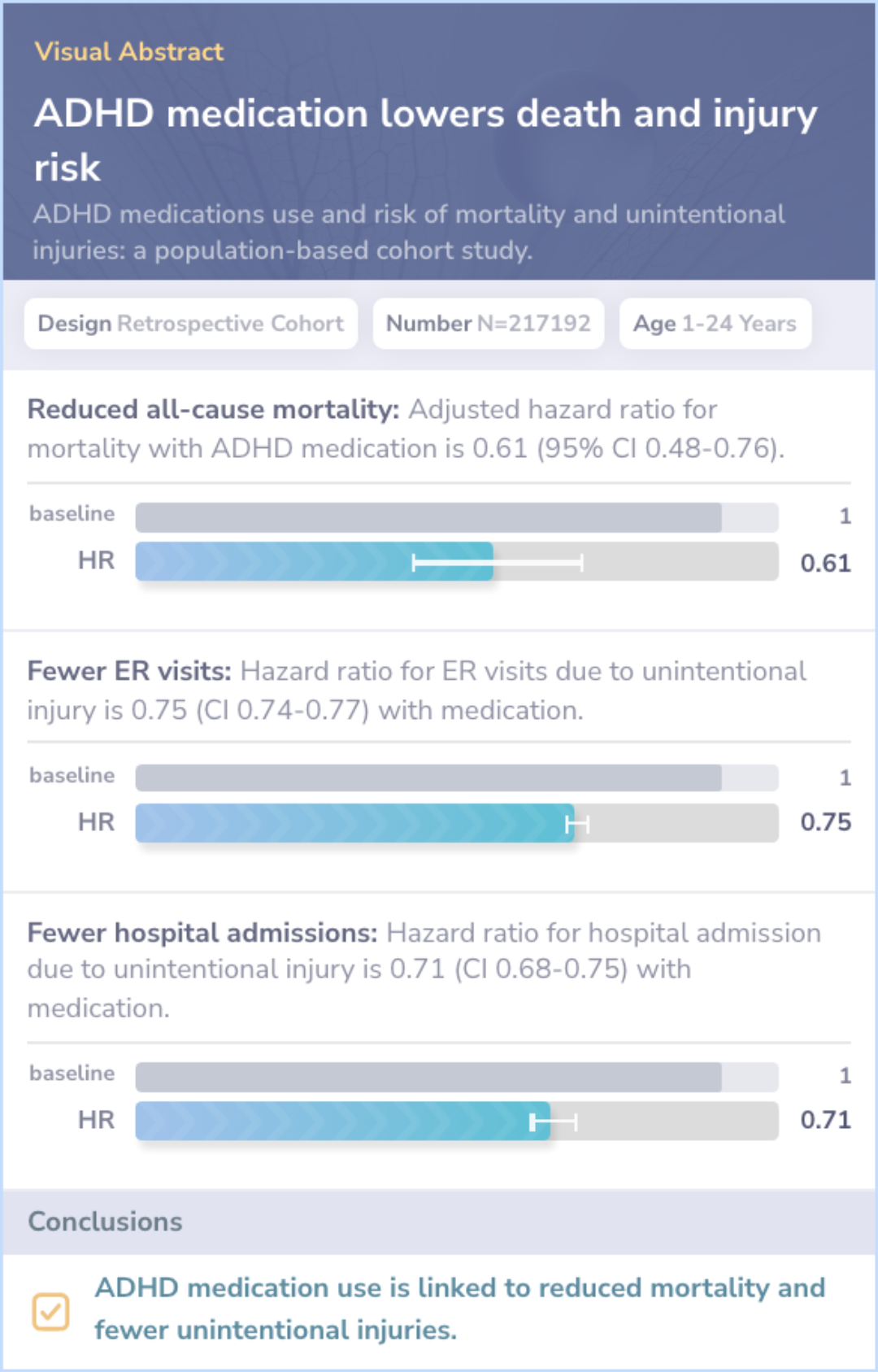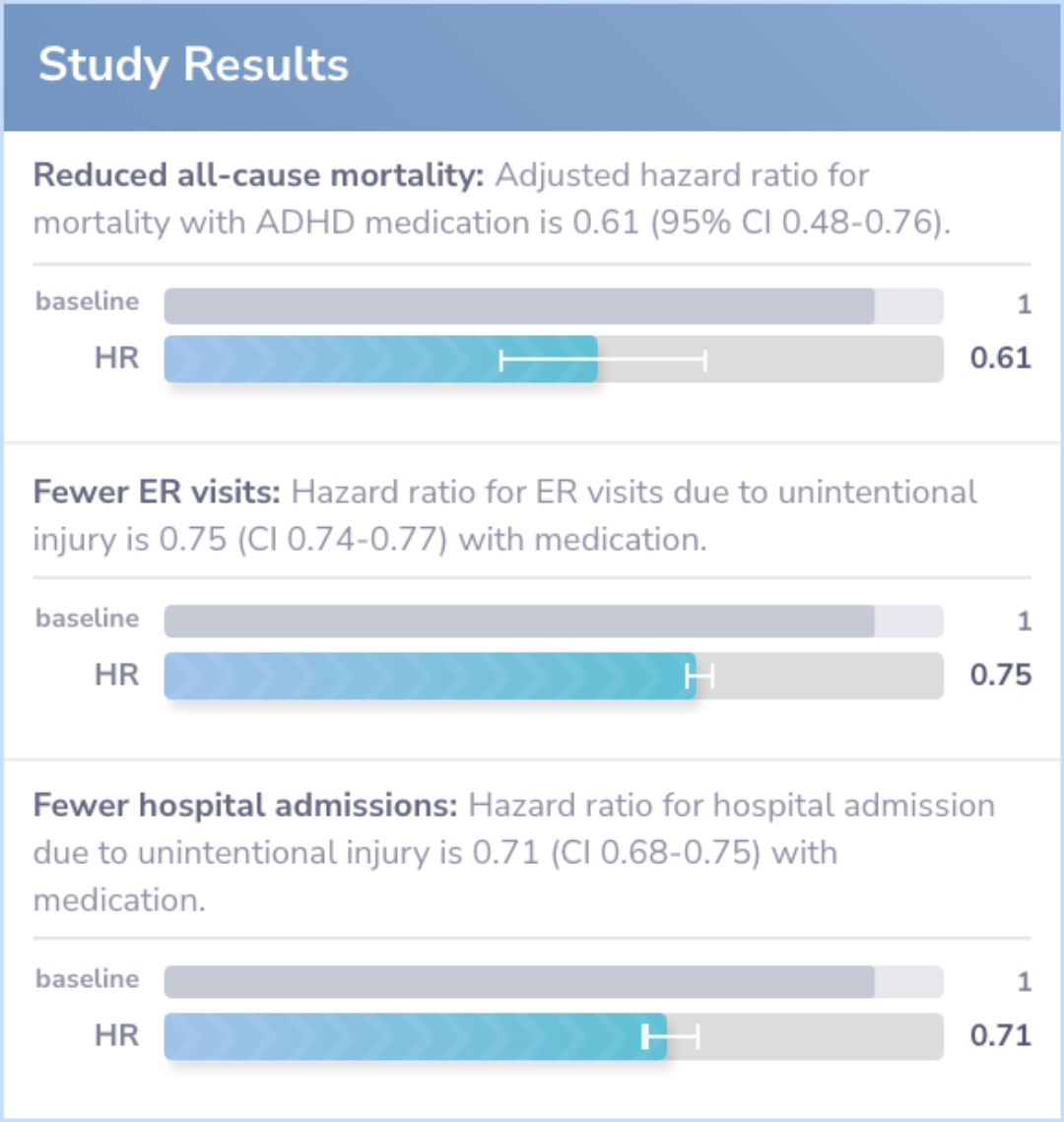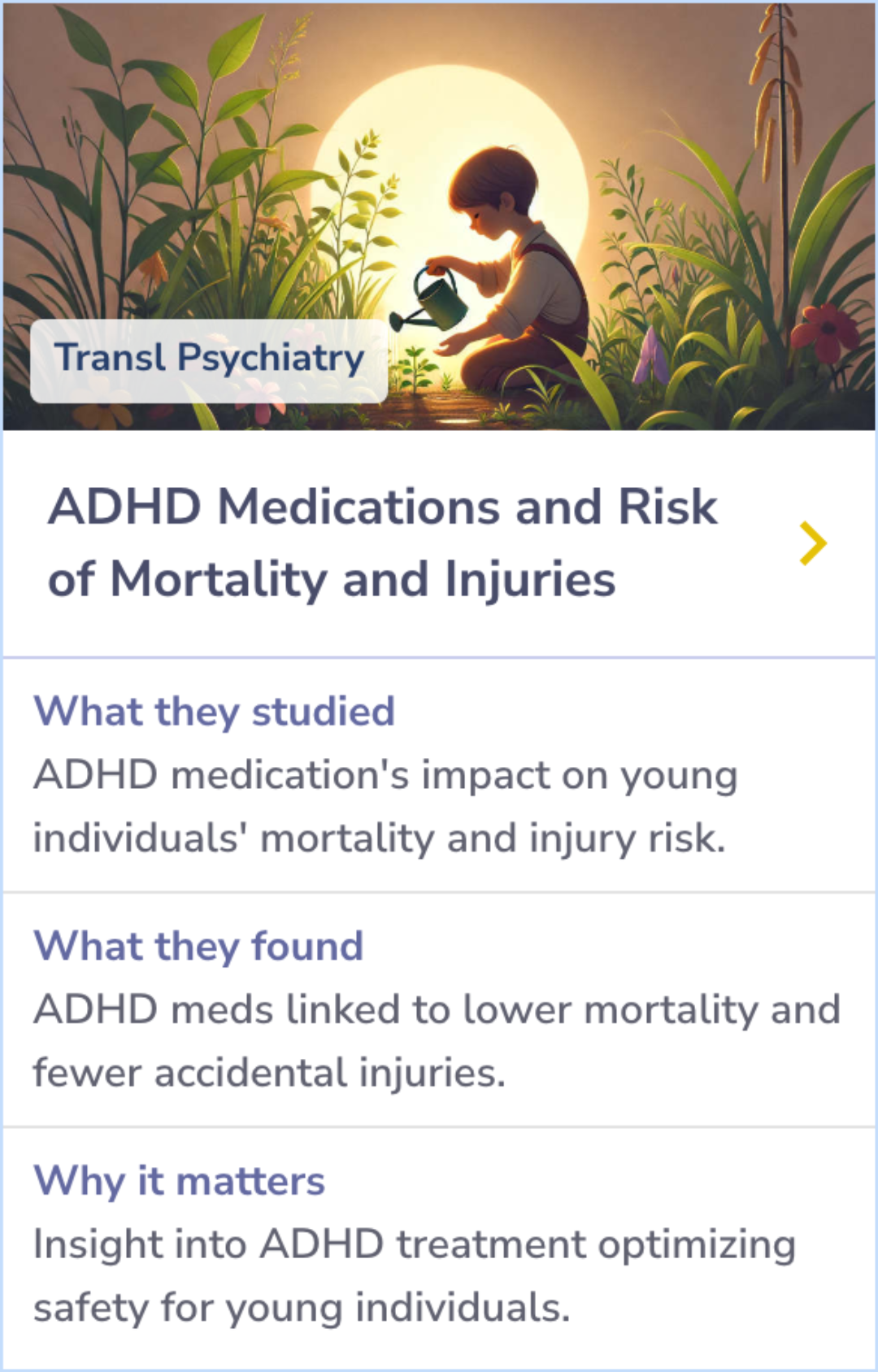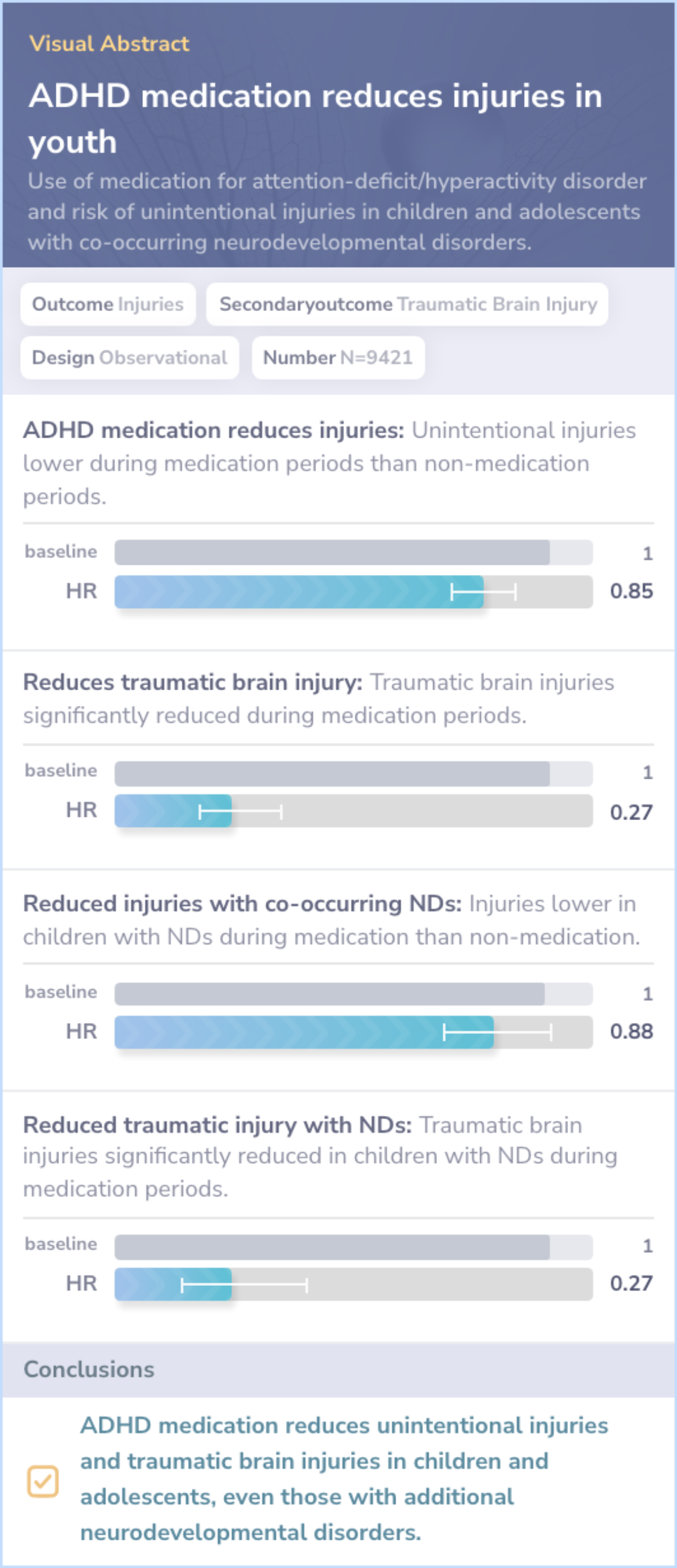Trending ADHD Papers
Visual Abstract
ADHD medications use and risk of mortality and unintentional injuries: a population-based cohort study
ADHD Medications and Risk of Mortality and Injuries
December 9, 2024
author
Vasiliadis HM, Lunghi C, Rahme E, Rochette L, Gignac M, Massamba V, Diallo FB, Fansi A, Cortese S, Lesage A
journal
Transl Psychiatry
Date Published
2024 Feb 28
Why link to a visual abstract?
What is a visual abstract?
Original

Study Summary
🔬
What They Studied
The researchers studied the impact of ADHD medications on the risk of all-cause mortality and unintentional injuries in individuals with ADHD aged 1-24 years.
💡
What They Found
The study found that ADHD medication use, particularly stimulants, was associated with a reduced risk of all-cause mortality and unintentional injuries.
📚
What This Means
These findings suggest that ADHD medications, especially stimulants, align with current evidence by effectively reducing related risks but must be balanced against potential side effects as mentioned in the evidence for ADHD treatments.
Study Overview
Background & Objectives
Methylphenidate, a central nervous system stimulant, treats ADHD and narcolepsy by increasing norepinephrine and dopamine levels in the brain. It is prescribed in different forms like tablets and patches, specifically for those aged six and above.
A recent investigation looked into how taking ADHD medications affects mortality risk and accidental injuries requiring emergency or hospital care among young people diagnosed with ADHD.
A recent investigation looked into how taking ADHD medications affects mortality risk and accidental injuries requiring emergency or hospital care among young people diagnosed with ADHD.

Abstract: background
We assessed the association between the use of medications for attention-deficit/hyperactivity disorder (ADHD) and the risk of all-caus...more
Study Summary
Methods
Researchers conducted a broad analysis using historical medical records from Quebec, spanning 2000 to 2021, focusing on those with ADHD diagnoses or prescriptions. Participants were followed from their first encounter with ADHD-related health services until age 25, death, or study completion.
Medication usage was categorized based on insurance coverage and whether or not medications for ADHD were used, aiming to analyze the associated risks using complex statistical methods to interpret survival outcomes.
Medication usage was categorized based on insurance coverage and whether or not medications for ADHD were used, aiming to analyze the associated risks using complex statistical methods to interpret survival outcomes.

Abstract: methods
We conducted a population-based retrospective cohort study between 2000 and 2021 using Quebec health administrative data. Individuals w...more
Study Results
Results
The study examined over 217,000 young individuals with ADHD, finding a notable result: medication use seemed to lower risks of dying from any cause and suffering accidental injuries needing emergency or hospital care. Comparing genders, males predominated, nearly double females.
For those using stimulants like Ritalin and Adderall, there's a marked decrease in overall mortality risk. Both stimulants and non-stimulants reduced injury risks, indicating diverse benefits depending on the treatment approach used.
For those using stimulants like Ritalin and Adderall, there's a marked decrease in overall mortality risk. Both stimulants and non-stimulants reduced injury risks, indicating diverse benefits depending on the treatment approach used.

Abstract: results
The cohort included n = 217 192 individuals aged 1-24 years with a male to female ratio of close to 2:1. Compared to non-medication use...more
Study Summary
Conclusions
While other factors might have influenced results, the study suggests stimulant medications could lower general mortality risks for youth with ADHD. Both stimulant and non-stimulant therapies seem to mitigate risks of accidents.
These insights should guide health professionals when deciding on treatments, weighing potential benefits against any negative outcomes, to enhance care strategies for those with ADHD.
These insights should guide health professionals when deciding on treatments, weighing potential benefits against any negative outcomes, to enhance care strategies for those with ADHD.
Abstract: conclusions
Although residual confounding cannot be excluded, stimulants may have a protective effect in terms of risk of all-cause mortality and both stimulants and non-stimulants for ADHD may reduce the risk of unintentional injuries. The findings of the curre...more

Clinical Guidelines
Guidelines suggest that ADHD medication use reduces the risk of motor vehicle collisions. Stimulant medications are a first-line treatment for ADHD, demonstrating an effect size of around 1.0. ADHD is a chronic condition requiring long-term management using the chronic care model and medical home principles.
Methylphenidate is recommended as a first-line treatment for preschoolers, given the lack of rigorous studies for other medications. Behavioral therapy enhances treatment when combined with medication for pre-adolescent children.
Comorbid conditions should be considered in ADHD evaluations, screening for conditions like anxiety, depression, and learning disorders.
Methylphenidate is recommended as a first-line treatment for preschoolers, given the lack of rigorous studies for other medications. Behavioral therapy enhances treatment when combined with medication for pre-adolescent children.
Comorbid conditions should be considered in ADHD evaluations, screening for conditions like anxiety, depression, and learning disorders.
Literature Review
[Ghirardi] et al, [2020]
Core Insight:Both studies observe that ADHD medication is linked to reduced injury risks in youths, with added understanding of effects on those with co-occurring neurodevelopmental disorders.
What It Adds:
Population Differences: Main paper examines wider age range and all-cause mortality.
Co-occurring Conditions: This paper includes those with other neurodevelopmental disorders.

Literature Review
Ghirardi et al, 2020
Core Insight:Both papers find that ADHD medication is linked to fewer unintentional injuries in young individuals.
What It Adds:
Comparison Across Sexes: The comparison paper highlights reduced injury risk for both boys and girls.
Broader Age Range: The primary paper examines a wider age range, leading up to 24 years.
Shared Themes:Both studies demonstrate that ADHD medication is associated with lower unintentional injury rates.

Literature Review
Li et al, 2024
Core Insight:Both papers investigate how ADHD medication affects mortality, with a focus on all-cause and unnatural-cause deaths.
What It Adds:
Age Range and Follow-Up: The main paper studies individuals up to 24, the comparison paper up to 64.
Focus on Mortality Causes: Comparison paper highlights natural vs. unnatural-cause mortality.
Shared Themes:Both studies support that medication is linked with lower all-cause mortality rates.
